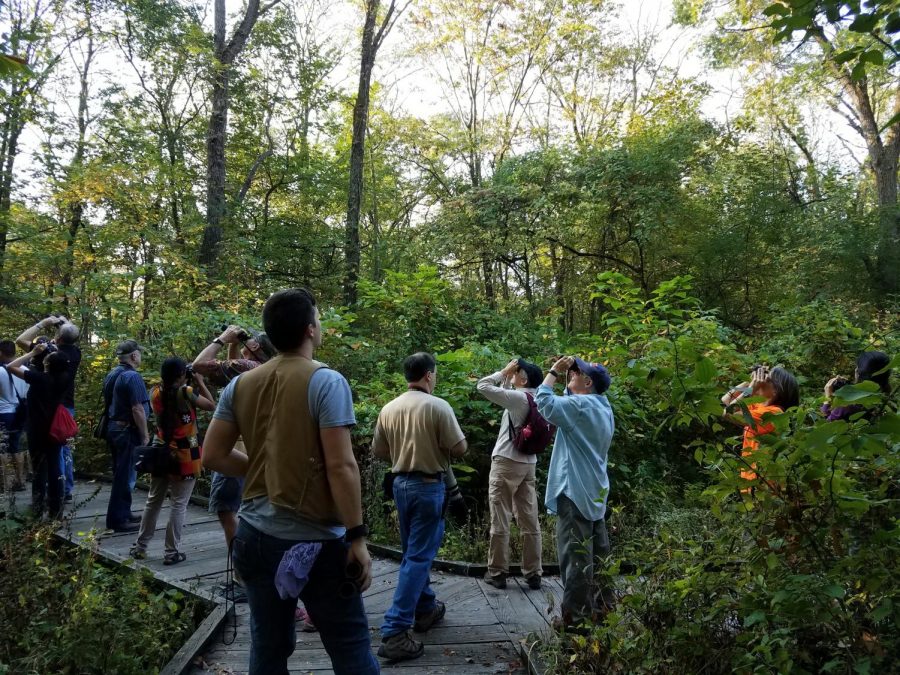Champaign residents share interest in birding
Photo Courtesy of Rachel Vinsel
The Champaign County Audubon Society searches for birds to watch during a morning walk in Fall 2017. Their annual Christmas Bird Count can help with scientific research efforts.
Mar 8, 2021
Observing natural patterns in the wild has always been an important aspect of science. Many consider Charles Darwin as history’s most famous naturalist. However, since his expedition to the Galapagos in 1835, many scientists and organizations have contributed to ecological research.
One of these grassroots organizations is the Audubon National Society, which has been around since 1905. Its mission is to promote interest in all aspects of the natural world and encourage restoration efforts worldwide. Luckily, there are opportunities for community members to get involved with the Champaign County Audubon Chapter.
Sara Johnson is the communications committee chair for the Champaign County Audubon Chapter. She touches on the history of the national organization and the importance of birding.
“The creation of Audubon was a response to a change in the views surrounding conservation at the time and concern that natural habitats and wildlife (particularly birds that were harvested in enormous numbers for the feather trade) were rapidly declining,” Johnson said.
There are currently over 500 chapters in the United States, and Champaign’s chapter is part of the network.
Get The Daily Illini in your inbox!
“There is a network of local chapters all over the state including our neighbors, Middlefork Audubon Society,” Johnson said. “The Champaign County Audubon Society started as a club in 1940 and was made a formal Audubon local chapter in 1945.”
For $15 a year, members have access to Audubon’s newsletters and special member-only events. The organization also offers public hikes open to members and the general public, monthly seminars where they host speakers and researchers and great programs like the Nerds Who Bird Trivia. One of their most popular activities is the Sunday Morning Bird Walks, which started over 75 years ago.
“Not only is this a great opportunity for our local birders to get out and bird together, but the data we collect during these walks also acts as a bird census,” Johnson said. “Our records go back as long as the walks have been going!”
Audubon also attracts those who are interested in research opportunities, which is a community effort. For example, the organization’s annual Christmas Bird Count relies on community members’ data documenting trends in resident birds throughout the country. Hundreds of scientific studies utilize this data to document species trends, identify hotspots of diversity and improve conservation for species at risk.
“I think many view science as something reserved for ‘people who know better,’” Johnson said. “If there is anything that birding teaches us, community-sourced data can be some of the most important and prevalent data we have regarding long-term trends of bird species in America.”
Audubon often collaborates with local parks and preserves such as the Urbana Park District and the Champaign County Forest Preserve. They also join forces with Audubon Great Lakes, the Audubon Council of Illinois and the Illinois Ornithological Society to promote events and share experiences.
Since the pandemic, the local chapter has shifted its focus to producing videos and offering webinars.
“On our YouTube channel, you can find some of our past webinars as well as some other promotional videos regarding our bird counts and hikes,” Johnson said. “We also have been conducting bird-a-longs on Facebook Live in the new year.”
While they are slowly opening back up to in-person programs, they focus on limiting the number of people to maintain safe conditions for our attendees for spring birding.
“We frequently have up to 40-50 people on our Sunday Morning Bird Walks!” Johnson said. “While this is very exciting, we, of course, can’t sustain those numbers during COVID-19 times, so we are adapting, but excited to see some of our friends in person again, safely.”
Birding is not only fun, but it can reveal similarities between how humans and birds behave. Johnson believes that humans are tied to nature, and, as urban city-dwellers, we often try to quiet the natural cycles of life. Birding flows with this natural cycle.
“Birds migrate south in the fall to their over-wintering grounds, sometimes in massive migrations like the Sandhill Crane, which pass through the Midwest,” Johnson said. “We return to the indoors to wait out the harsh cold days of winter, feeding our birds to catch a glimpse of them out our windows.”
One of the first announcements of long-awaited spring is the return of red-winged blackbirds in late February. Their return signals that migration is coming and soon greenery will come back to the world.
“Birding not only utilizes all our senses, allowing us to practice using our eyes and ears to look and listen for birds, but it also can be meditative, offering us peace and quiet in an otherwise hectic society,” Johnson said.
The Champaign Country Audubon Chapter is trying to maintain its historical programs. However, members are thinking of better ways to be more inclusive and equitable in their programs and outreach efforts.
“We have learned that we need to change with the times to stay relevant, and COVID has challenged us to reach people in new ways,” Johnson said. “We have been thrilled that our members have responded so graciously to our online events, but we look forward to engaging with our members, birders and friends again soon.”
Jillian is a senior in LAS.






